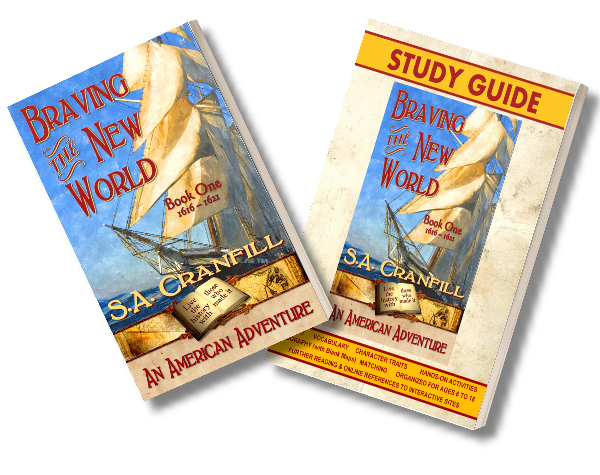
Real History with Real Imagination
I love ships. Especially tall ships. But I have never ridden one for weeks across the high seas, angry or calm. The cover artwork of Braving the New World is intended to help us feel the waves and the sea spray, to hear the flapping of the mighty sails and the creaking of the masts. Should we be concerned about pirates? We should definitely be worried about storms, our food and water supply, the challenges of our destination, and so on. How brave were the people who ventured across the Atlantic Ocean to this New World? The soldiers, the explorers, the adventurers, the ordinary families? Young children, pregnant women? Would we have the courage to do so?
Our own courage for such a risky and life-changing adventure is something we can’t truly measure because we are of a different time and place. But the more we explore the documents and letters that contain the very words and deeds of those long-ago travelers, the better we can measure their bravery and determination and try our best to imagine their experiences. By way of historical fiction (with emphasis on the history), we can embed our own dedicated reporters to join the journeys of those explorers and settlers and allow us to “live the history with those who made it.”
A Vest-Pocket Ride Along
I’ve employed a clever and charming young mouse named Falstaff (no relation to Shakespeare’s carousing character) to immerse us in a very personal, vest-pocket ride-along journey with both familiar and unsung heroes of America’s foundation. In the pages of Braving the New World, we develop relationships with these people. We travel the streets of London and visit a very real book seller. We ride the decks of ships, negotiate storms, scurry through Whitehall Palace, and spend a year in Cuper’s Cove, Newfoundland ~ Britain’s second successful colony in America. We get a guided tour of England’s discovery of Long Island and Manahatta and the plantations of Jamestown Colony on an 80-mile trip up the James River. We meet the real Pocahontas and John Rolfe and John Smith, reside with the London merchant John Slany, visit Sir Ferdinando Gorges at Plymouth Fort, fight with the Indian Epenow on Martha’s Vineyard, and sail the American coast with Captain Thomas Dermer and Squanto. We travel the early trails of eastern Massachusetts, live with Massasoit, and see the Pilgrim landing from the Indian perspective.
I interpret the people and events with three approaches: the documented, the probable, and the possible, marrying the determined curiosity of a history addict with the enlivened imagination of a playwright. What did happen? What very well might have happened? I try to stay within the well-defined lines as best I’m able while filling in with as much color as the known facts permit.
What If? What then? Who Might We Be?
Braving the New World is intended to be a personal adventure through American history and culture and the European and especially British history that created us, gave us what we have, and made us who we are today. How did England come from far behind to eventually dominate the race for the New World? How many life-changing “nicks of time” were there? What decisions, choices, or tip-the-scale details could have turned a drastically different page in our history? And who would we then be???
The savory stew of history demands all of its spicy ingredients ~ not just dates, events, and leaders, but the rich, full context of culture, literature, religion, inventions, occupations, education, daily life, entertainment, and many individuals not so well known who deserve our attention. And it demands the best of our imagination. As I began researching the recipe for this entertaining tale of history and fiction, I realized that, in the year 1616, Captain John Smith, Pocahontas, and Squanto were all present, at the same time, in what was a relatively small city of London, and all were major actors in the drama of British colonization. Into the pot of genuine events, toss a very real merchant named Slany, a very fictional mouse with a Shakespearean manuscript, and a very real bookseller named Clerke, stir vigorously with imagination and ~ what could have happened? How might they ~ and how did they ~ interact to tell us the tales of their time?
Braving the New World, Book One, 1616 to 1621, is currently written and in production for an early 2021 release. For every reader, a chapter-by-chapter commentary is planned for the back of the book to clarify fact from fiction when need be and list important sources. The Study Guide will release at the same time as Book One and will feature maps, memory and comprehension exercises, and activities for a wide age range as well as guidance for further studies. An extensive Reference and Source List will be made available in the Study Guide and also for download at HistoryNerd.fun. Braving the New World, Book Two, 1621 to 1702 is partly written and is intended to follow Book One as fast as our mouse can run.
